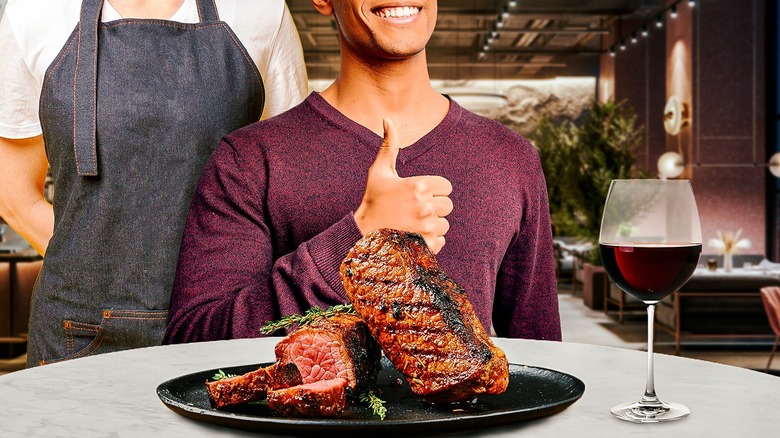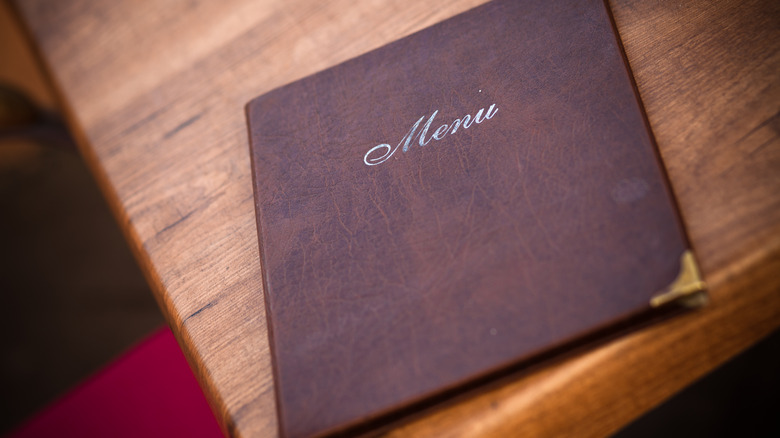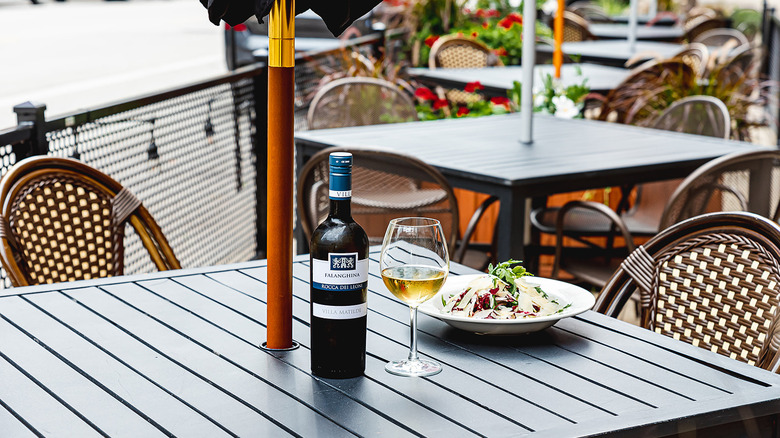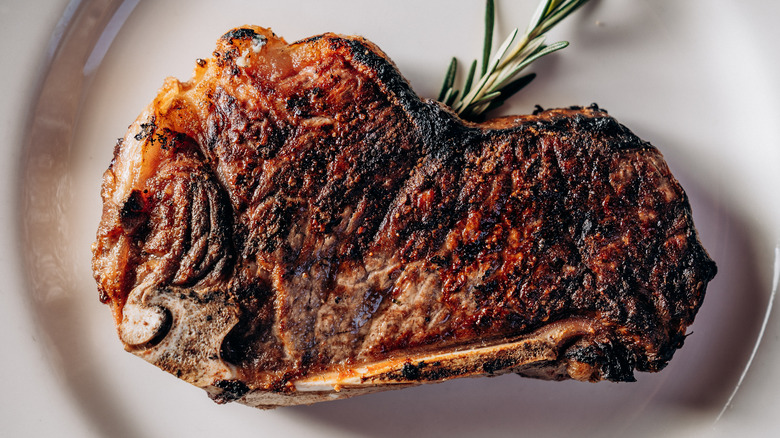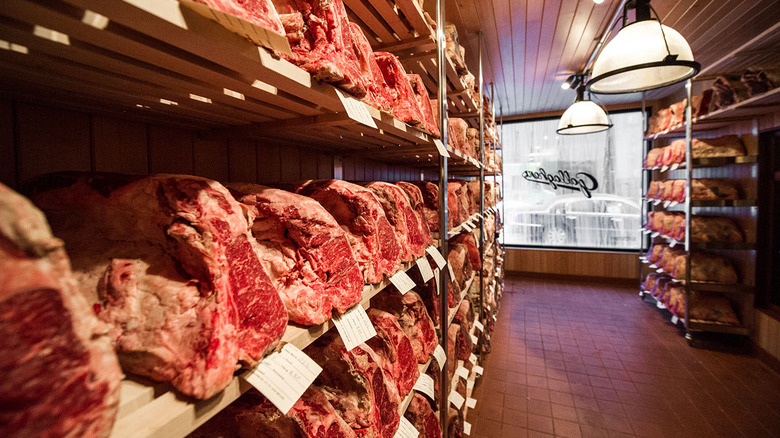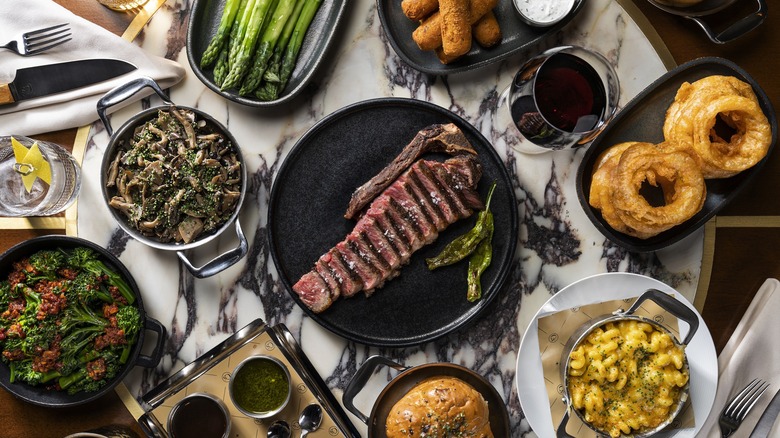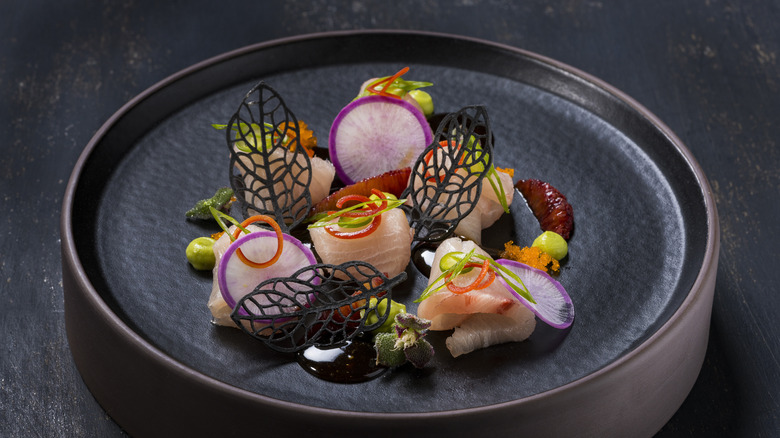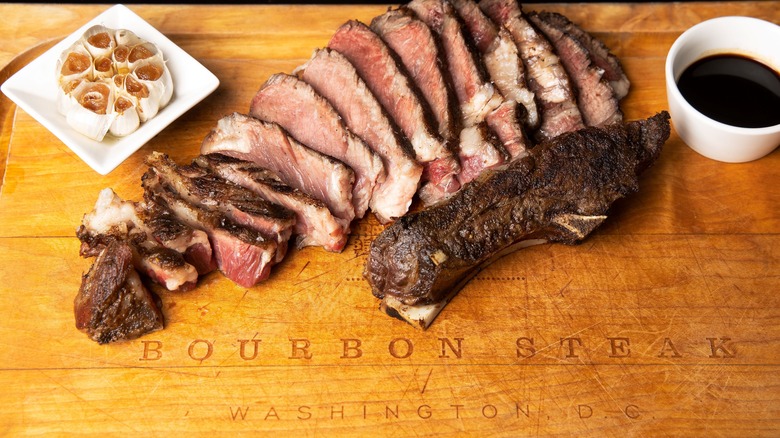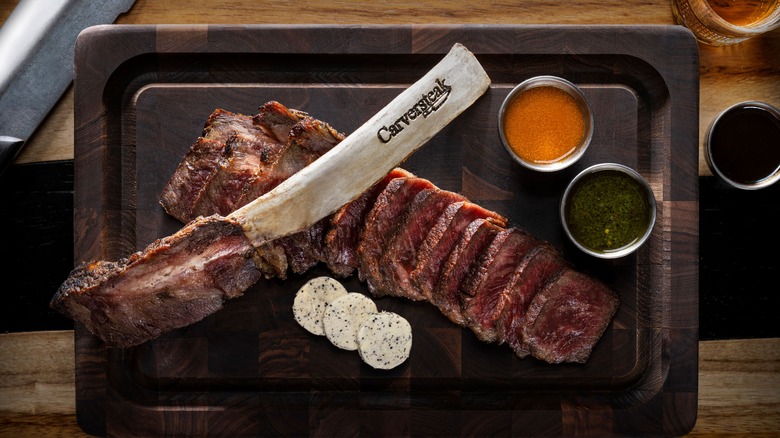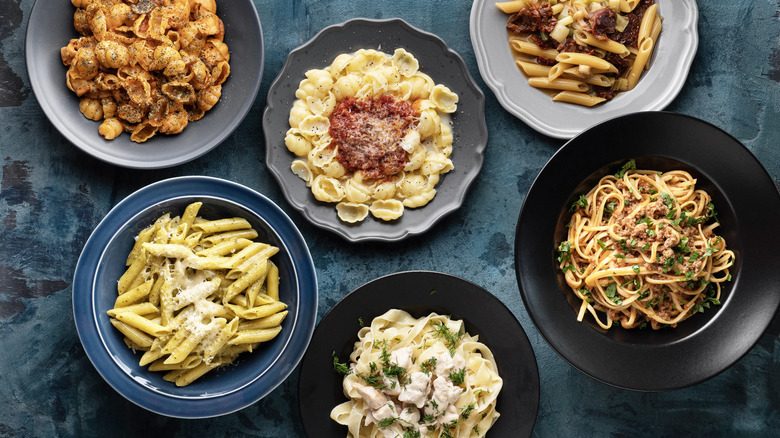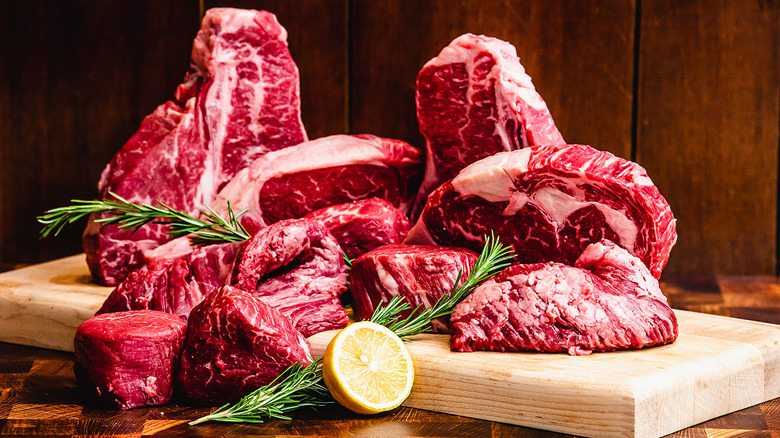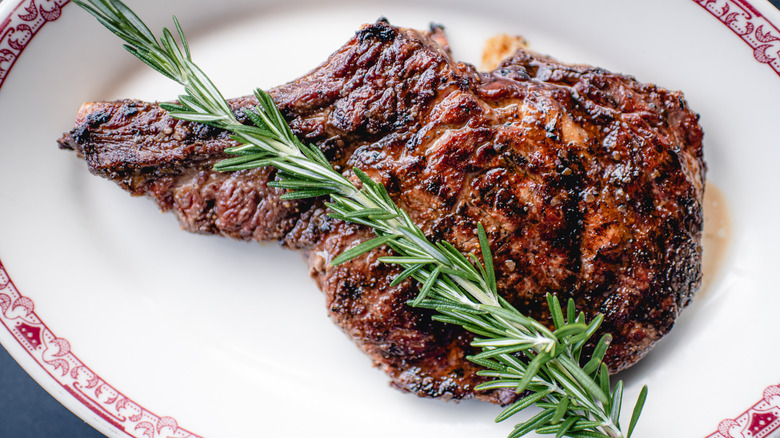13 Tips For The Best Dining Experience At A Steakhouse
A good steakhouse experience can be one for the ages — and we don't just mean the ages of the steaks in the meat locker. A steakhouse with a friendly staff, pleasant music, and a menu packed with delicious dishes and bold, beautiful wines can make the average night out at a restaurant anything but. Whether you're a first-time steakhouse diner or a red meat regular, you should know there's more to having a good steakhouse experience than properly cooked meat and a nice wine to go with it (although we must say that is important, too). We talked to some choice experts about steakhouses to get their take on navigating your way to an unforgettable steakhouse meal from beginning to end.
Meet the experts: Daniel Ontiveros, executive chef at Carversteak; Mark Bucher, owner of Medium Rare and founder of Feed the Fridge; Dean Poll, owner of Gallagher's Steakhouse and formerly of Loeb Boathouse; Michael Mina, chef at Bourbon Steak DC and founder of the Mina Group; and Michelle Durpetti, third-generation owner of Gene & Georgetti. From doing your menu and meat research beforehand to knowing what to drink before and during your meal and asking the right questions to your server, we think this is some top-tier, USDA prime knowledge to give you the most delicious and enjoyable steakhouse experience.
Research the restaurant ahead of time to understand its highlights and crowd-pleasers
With the internet at our fingertips, it's tempting to research a restaurant before you eat there. For some, this may seem like reading spoilers for a movie you haven't seen yet; do you really want to know exactly what you're ordering before you even show up? For chef Michael Mina, it's okay to do just that. You're not spoiling the meal just by looking up what the restaurant has to offer; in fact, you're allowing yourself to understand what they may be known for so you can make your decision an educated one.
Whether you use a Yelp page, Instagram, or even the restaurant's website, giving yourself an idea of what the steakhouse is known for can greatly improve your dining experience, especially if you're a first-time steakhouse visitor. Steakhouse menus are meaty (pun certainly intended), offering much more than just a few chops and a side or two. Do some research beforehand, and find out what's best for you.
Think about the kind of experience you want
Steakhouses have changed a lot over the last decade, and for chef Mina, it's important to think about the kind of steakhouse experience you want. If you're up to speed on steakhouse trends, you know you've got options. Maybe you're drawn to the more traditional steakhouse, with vest-clad servers, shrimp cocktails, and martinis the size of your head. Or perhaps you want a more modern vibe, where the chef will come to your table and sensually salt your steak before you eat it. Either way, finding a steakhouse that meets the moment for you is important.
If you're not quite sure of the type of experience you want, start by doing some research on the menu itself. A classic steakhouse will most likely include a classic cocktail menu, too, so keep an eye out for a martini, an old fashioned, a Manhattan, and the like. Also, dishes like potatoes au gratin, creamed spinach, and a wedge salad will fall under the classic category. That doesn't mean the modern approach is one to avoid. Quite the contrary, as Mina notes, a good steakhouse does the classics well while also featuring product and technique-driven dishes that go outside the traditional box.
Find out what kind of steaks and chops are served and where they're sourced
We believe this may be the most important tip, and you're about to find out why. A good steakhouse takes the sourcing and preparation of its meat very seriously, and according to Michelle Durpetti, as a diner, it's more than okay to want to know where that meat is coming from and how it was treated. If you know what you like, you should feel comfortable asking for it from your server. If unsure, you should feel comfortable asking questions and finding out what's best for you. For example, Durpetti notes that dry-age cuts tend to be richer, a flavor profile that may not be for everyone. A filet will be leaner, while a ribeye has more flavor from the marbling but can become a bit heavier. Asking the right questions and getting a full understanding of what is on offer will make your dining experience a more satisfying one overall.
Look at the aging program for the restaurant
Did you know some steakhouses will dry age their steaks for well over 100 days? That may seem like a waste of time for the steakhouse novice, but many will argue that the longer a steak ages, the more the meat breaks down, making it a more tender cut. So, while that 100 days may sound outlandish, it will make for a bolder, more flavorful steak. For chef Daniel Ontiveros, knowing the aging program of a steakhouse is a great way to improve your dining experience since you'll have a better understanding of how they treat their meat and the flavor profile you're getting from the finished product.
Flavor-wise, there is a difference between wet aging and dry aging. A wet-aged steak tends to have a sweeter flavor that pairs well with different seasonings and sauces, whereas a dry-aged steak has a beefier flavor that doesn't need anything more than a good sprinkling of salt and pepper. Prices will also vary for these different aging techniques, with a dry-aged steak coming in at a much higher price than a wet-aged one. Most steakhouses will include that information on the menu, but it never hurts to ask your server if you're still unsure.
Be patient as you wait for your table to be ready
Patience can be hard to muster when you get to dinner when all you want to do is sit down and order that delicious steak, but Dean Poll recommends keeping your cool when you arrive and waiting your turn. Yes, it can be frustrating to wait around for your table to be ready among a crowd of other hungry people even if you did book ahead, but it's so important to make a reservation in the first place because demand is high during peak days and times. Cut the host or hostess some slack, and be prepared to wait a few minutes for your table to be ready, especially if you're showing up for dinner at 7:00 p.m. on a Friday or Saturday night. Letting it impact your dining experience, which hasn't even begun until you're seated, will take away from the best part: eating!
Have good communication with your server
If you've ever eaten at a great steakhouse, you know that the servers there are no joke. They know everything about the menu, inside and out, from the steak options and the specials of the day to the wine menu and maybe even a few personal recommendations from their own tasting experience. They are well-versed in answers to just about any question you may have, and having that kind of knowledge can be really important if you're the type of diner who asks many questions. For the best dining experience, Poll recommends having good communication with your server to ensure you know exactly what you're getting.
On the other hand, while your server is certainly up-to-speed on everything the menu has to offer, if you are asking for something specific, like how something tastes or how it's prepared, and your server lets you know that they don't know the answer, don't hesitate to ask them to find out. Pay it forward; you get what you want, prepared the way you want it, and the server will be better informed the next time someone asks them a similar question.
Start with cocktails, and only order red wine when the steaks arrive
Red wine and red meat may seem stereotypical, but it isn't without good reason. The tannins in your red wine soften the fat in the meat, which helps to release that savory, beefy goodness in each bite. Going the other way, the fat in the meat will soften the wine, helping to mellow out the flavor of even the heaviest Cabernet Sauvignon, producing a juicier, more fruit-forward sip.
When you arrive at your steakhouse of choice, you may immediately think you need to kick things off with a big, bold glass of red wine, right? According to Mark Bucher, stop doing that. Order a welcome cocktail instead rather than ordering a glass or bottle of wine as soon as you sit down. He notes that if you start with the red wine before the steaks arrive, those tannins that do such good work during the eating process will dull your taste buds, resulting in a steak that tastes bland instead of flavorful. Let the red wine do the heavy lifting during the entree; before that, treat yourself to an aperitif like a negroni to prime your belly before that big meal arrives.
Always order a few shareable appetizers for the table
We love a tip that includes shareables for the table. For Chef Ontiveros, one of the best ways to ensure a positive steakhouse dining experience is to have a top-notch selection of shareable appetizers for the table to kick things off on a truly delicious note. Some examples include steak tartar, sashimi, crudo, and caviar service if you feel truly fancy.
While appetizers may not seem an important part of the steakhouse experience, starting your meal with a primer is a great way to ease into the meal since the focus is primarily on the steaks themselves. Starting with some light but exciting starters, like a shared salad or freshly shucked oysters, may just elevate your experience. A meal at a steakhouse isn't meant to be quick; it's meant to be stewed over and enjoyed. Ask your server for their recommendations if you're unsure where to start, and after that, sit back, relax, and don't rush the process.
Forgo ordering anything with a bone on or in it
When you sit down at that steakhouse and open up the menu, chances are your eyes will go straight for the section with all those juicy steaks and chops and then immediately to the price that goes with them. And as you probably know, good meat doesn't (and shouldn't) come cheap. However, according to Bucher, if you want to enjoy a good steak without a heavy price tag, skip over anything with a bone in or on it. That list of steaks on the menu, in addition to price, is accompanied by its weight in ounces, which includes the bone. Going with the boneless cut rather than the bone-in gives you the same quality without the extra ounces.
With that being said, opting for a boneless ribeye, for example, rather than the bone-in ribeye, doesn't mean you're getting a lesser cut of beef. In fact, some of the most delicious cuts of beef are boneless but still deliver the same tender, meaty flavor as a bone-in option. The boneless ribeye we've already mentioned, but there's also a New York strip loin and a filet mignon, both of which are high-quality cuts of meat and can be truly unforgettable when prepared at the right temperature.
Learn the different temperatures for different cuts of steak
Steak and burger enthusiasts, now is the time when your beef temperature preference can truly be appreciated. The regular steak eater is locked and loaded with their go-to temperature for whatever they order. While it's good to know what you like, Bucher recommends getting educated on the best way to enjoy different cuts of steak, starting with the best temperature. According to him, the more internal fat a cut has, the further along it needs to cook to develop its ideal flavor fully.
While you may be accustomed to ordering medium rare or medium whenever you order a steak, regardless of the cut, you may miss out on a better eating experience by not understanding the relationship between fat and heat. A lover of the filet? Order it medium rare. Filets don't have much fat to render out, so cooking it to a lower temperature ensures you get a meaty, juicy bite without any chewy bits. More of a NY strip lover? Go for the Pittsburgh char — a cooking technique that heavily chars the outside but doesn't overcook the inside — medium. Got your eye on the ribeye? Ask for Pittsburgh char, medium plus.
Sometimes, the Italian side of the menu is better than the steak side
Before you blow an absolute gasket over what may seem like steakhouse blasphemy, give us a chance to speak up for the Italian side of the steakhouse menu. According to Bucher, many of the best steakhouses didn't start out that way; they started as different restaurant concepts and then transitioned into steakhouses. For example, Eddie V's, a steakhouse with locations nationwide, started with a more seafood-centric menu and then transitioned into offering high-quality steak options. Gene and Georgetti, a Chicago steakhouse that's been around since 1941, started out serving traditional Tuscan specialties before transitioning to steaks.
On the flipside, Bucher notes that RPM Italian, an Italian restaurant with locations in Washington DC, Chicago, and Las Vegas, has one of his favorite ribeye steaks for two. Ultimately, just because you're eating at a steakhouse, don't feel constrained to the red meat lane. If your steakhouse has an Italian menu section, perhaps a shared pasta for the table is a great way to get acquainted with it.
Don't order the biggest steak on the menu
Sounds a little mad, we know. But, according to Poll, going to a steakhouse and ordering the biggest steak on the menu will end up hindering your steakhouse experience rather than heightening it. Poll says it may seem like a self-serving statement from a steakhouse owner, but because of the large portions that typically accompany the steakhouse meal, ordering a massive steak as your main course may take away from all the other tasty treats you don't want to skip out on.
Appetizers tend to be substantial, and most sides are served family-style, meaning you're getting a lot of food during your meal. Add a 32 oz tomahawk chop to that; you may feel overwhelmed by it all rather than content. For Poll, the perfect dining experience is one where you can finish everything on your plate and feel completely satisfied. So, if that's the goal you're going for, size your steak accordingly. And, of course, always leave room for dessert.
Try your steak without sauce first
If you love slathering your home-cooked steak with your favorite steak sauce, we say slather on. However, if you're eating at a steakhouse and ordering one of their many delicious steak options, Durpetti recommends having your first bite sauce-free before any slathering commences. According to her, dumping steak sauce on your meat before tasting it falls under the steakhouse faux pas category. Since we would hate for you to be considered an unruly diner, we recommend following this advice.
Assuming you're eating at a steakhouse that has taken the time to age its steaks and season and prepare them to absolute perfection, it would be a shame to lose out on that attention to detail by covering it in a sauce that may not be necessary. If the chef wants the steak covered in sauce, says Durpetti, it will come to the table that way. Otherwise, take your first bite sauceless to taste the steak the way the chef intended.
